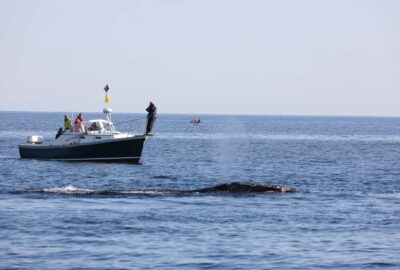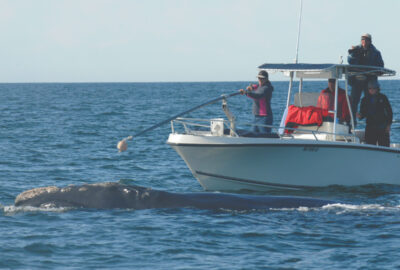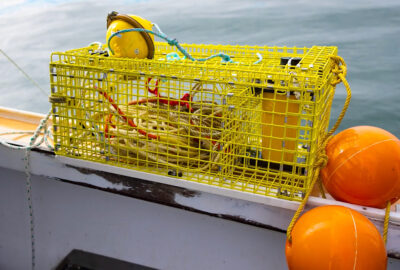Facing Human-Caused Threats, Right Whales’ Downward Trend Continues
By New England Aquarium on Monday, October 24, 2022

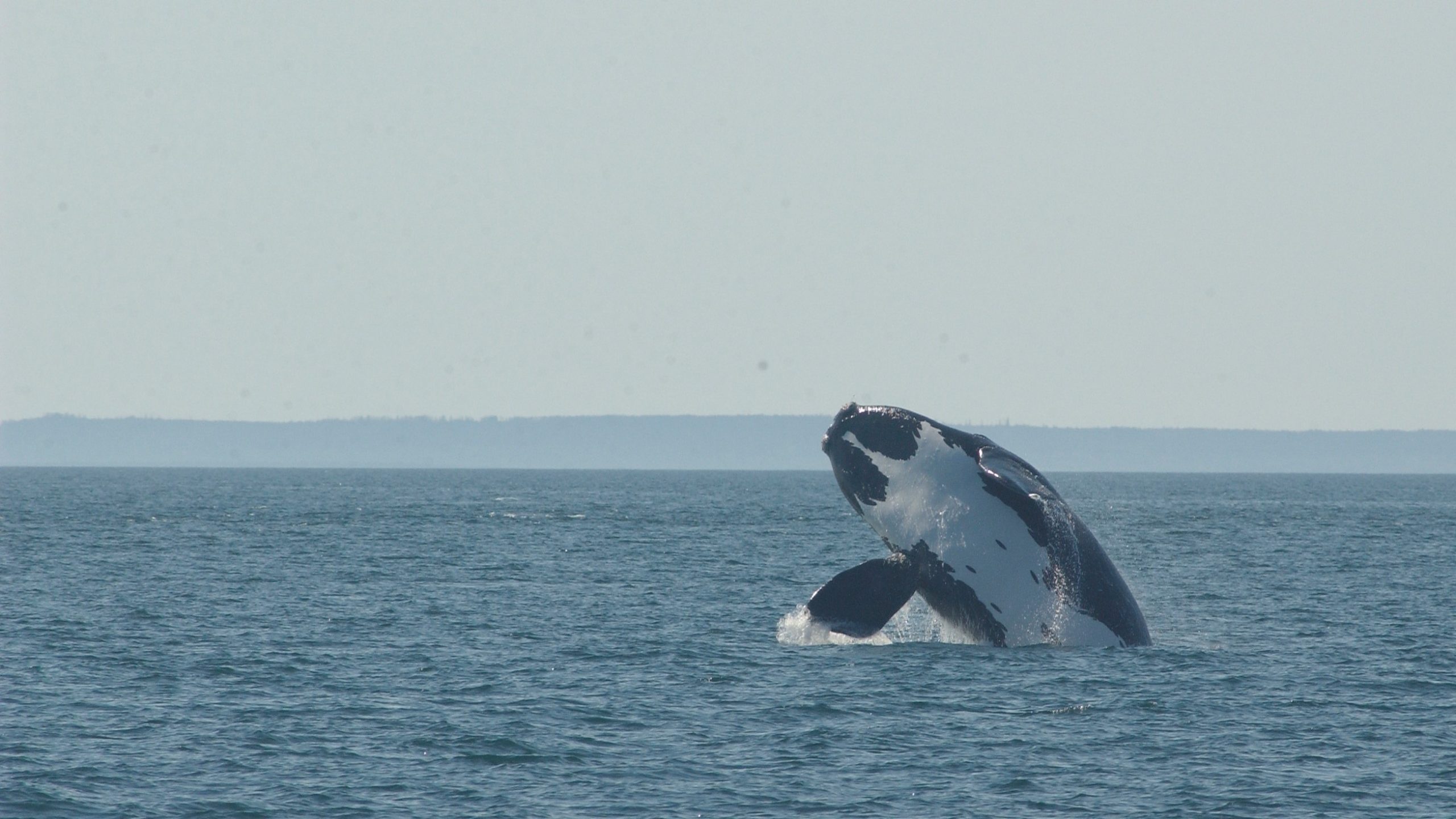
Updated March 7, 2023
North Atlantic right whales continue to face severe threats from humans. Entanglement in fishing gear, vessel strikes, and the shifting distribution of food sources caused by climate change have resulted in the species’ continued decline over more than a decade.
Each October, the North Atlantic Right Whale Consortium releases a preview of its annual report card on the status of right whales, including population estimates for the critically endangered species. Last year, the Consortium reported the 2020 estimate to be 336, +/-14 for range of error.
After completing the processing of photographic data from that calendar year, the 2020 estimate was adjusted within the range of error to 348 (+/-5). In this year’s final report, released in early 2023, researchers with the Consortium estimate that the species totaled 340 individuals (+/-7) in 2021. The current population estimate represents an ongoing downward trend amid concerns that human impacts on right whales are affecting the animals’ ability to survive and reproduce.
“While certainly good to see the slope of the trajectory slow, the unfortunate reality is that the species remains in a decline, with fewer than 350 individuals alive in 2021,” said Heather Pettis, research scientist in the New England Aquarium’s Anderson Cabot Center for Ocean Life and executive administrator of the North Atlantic Right Whale Consortium.
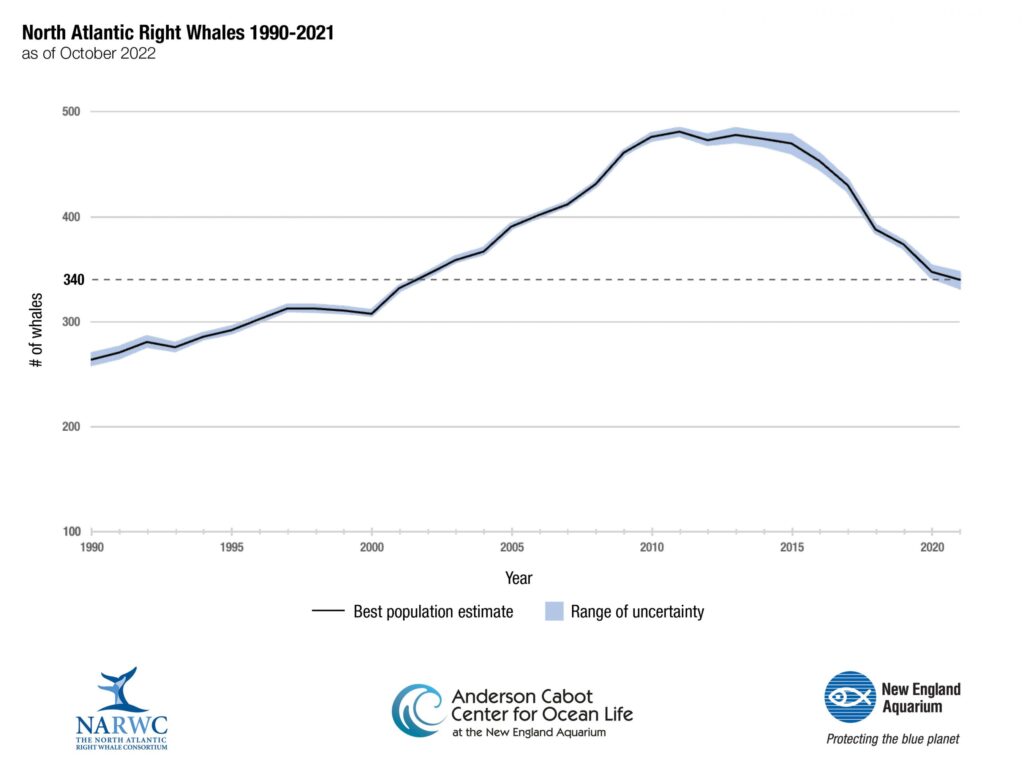
Right Whale Mortalities
Although no right whale deaths were detected in 2022, this is tempered by the fact that only about one in three right whale deaths are observed. To that end, two events suggest there were at least three unobserved deaths of right whales in 2022, including an entangled mother of the year and two calves.
Right Whale Calves
Fifteen mother/calf pairs were detected during the 2021-22 calving season—fewer than the 18 born in 2020-21 and far below the average of 24 calves produced per year in the 2000s.
Scientists also expressed concern that there were no first-time mothers, an observation that supported recent findings on the declining numbers of breeding females. In a recently published study on right whale reproductive rates, researchers estimated that there are only 72 reproductive females left.
“Reproductive females” are defined as whales that reproduced at least once and have been seen recently enough that scientists think they are still alive.
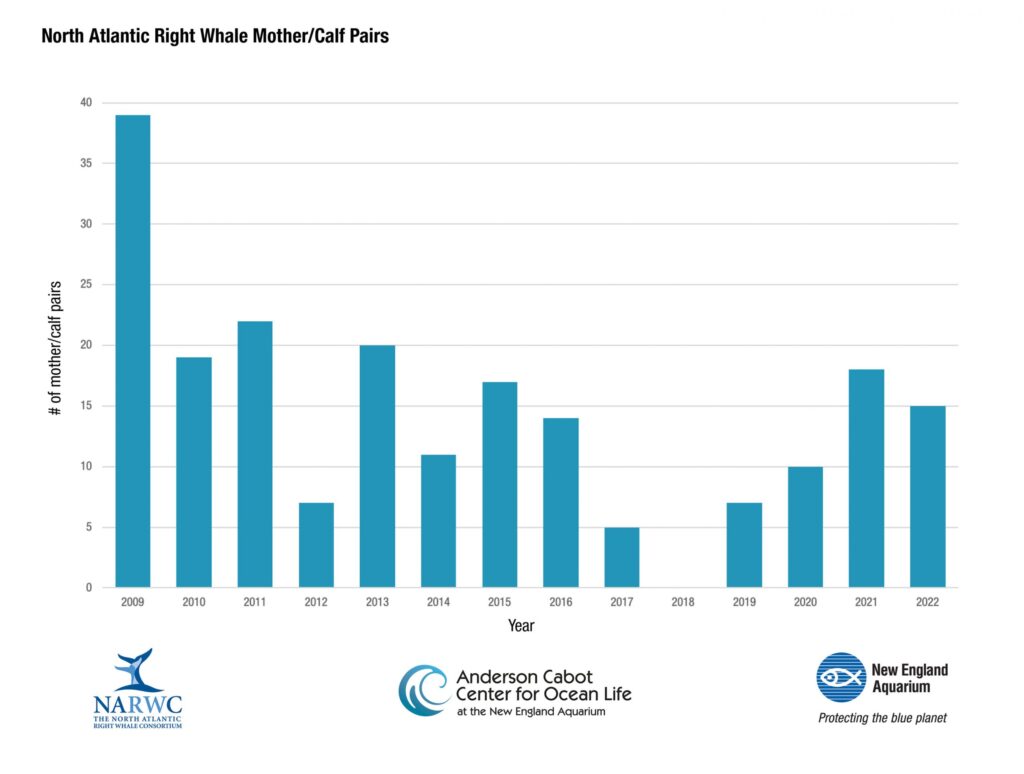
Human Impacts
In 2022, there were five entangled whales observed with gear attached, including Snow Cone (Catalog #3560), a reproductive female already suffering from a previous entanglement detected in March 2021 when she was pregnant. She was not able to be disentangled and she and her 2021 calf are likely both dead. The status of the other four entangled whales is uncertain as only one has been observed subsequently and remains entangled.
In addition, there were 11 detections of new right whale entanglements, which were evidenced by wounds or scars only. These cases, together with those whales with attached gear, represent a minimum number (16) of new entanglements for 2022 and highlight the importance of efforts to prevent right whale entanglements. Additionally, there was one detected vessel strike to a right whale this past year.
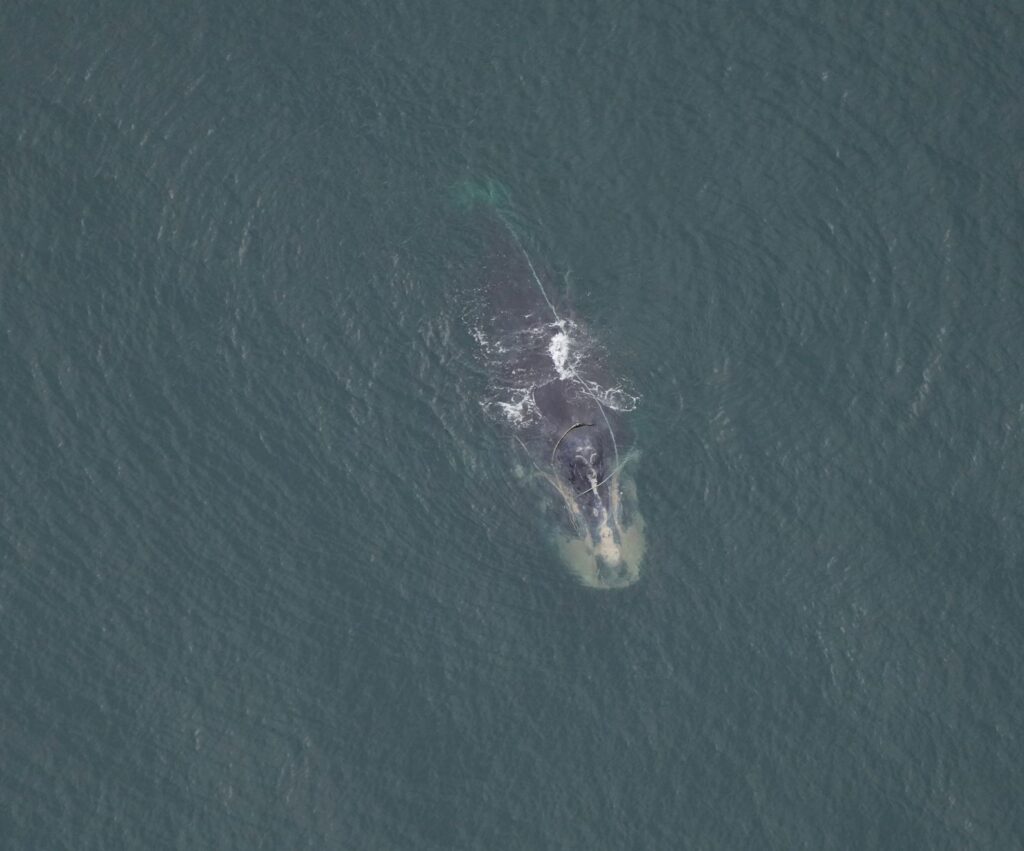
“We continue to see unsustainable levels of anthropogenic injury to right whales,” said Dr. Scott Kraus, chair of the Consortium. “A lot of hard work has gone into protecting these whales, but the hard truth is it hasn’t been enough.”
As part of the unusual mortality event that began in 2017, NOAA Fisheries tracks the cause of death for each documented right whale death. Human-caused factors, including entanglement in fishing gear and ship strikes, have been implicated in 20 of the 34 deaths documented from 2017-2022.
Entanglements in fishing gear can cause whales to drown, but many entanglement deaths are prolonged. As they swim, an entangled whale can drag hundreds of feet of heavy ropes and gear, which can cause critical injuries. It also puts the whales under intense stress and often interferes with their energy balance and ability to feed. A severely entangled whale may eventually starve if ropes wrap around its head and mouth, restricting its ability to eat.
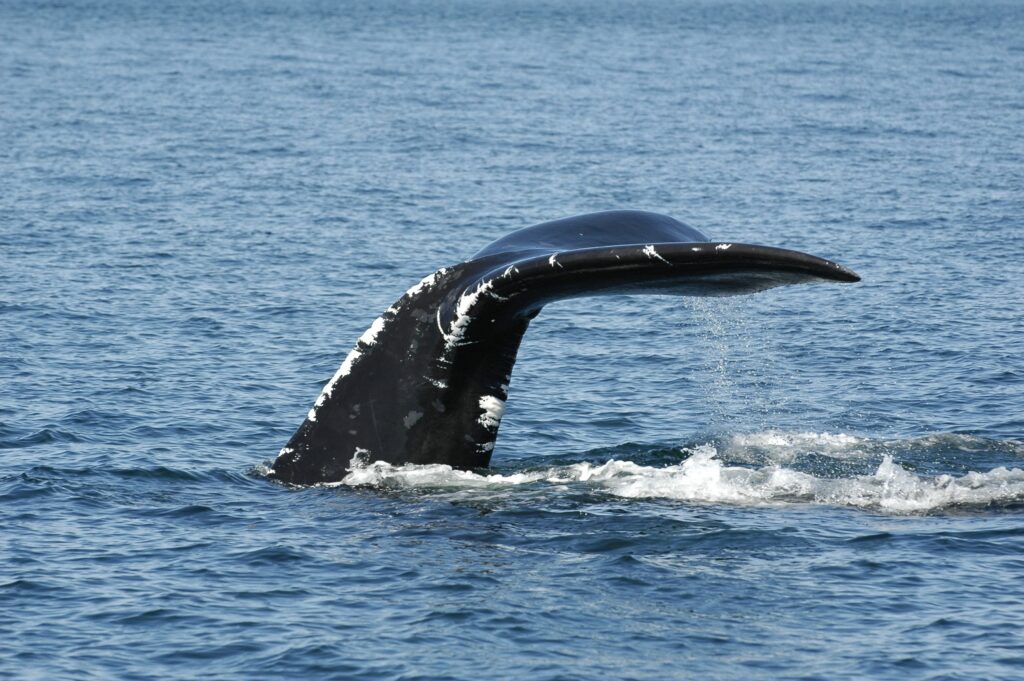
Even if fishing gear is successfully removed by a disentanglement team, or if a whale is able to shed the gear themselves, the injuries they sustain can lead to poorer health, including stunted growth and reduced reproduction. Research has shown that smaller female right whales have fewer calves per reproductive year, which may limit the population’s ability to rebound at a time when birth rates for these whales is already at a 40-year low.
Eighty-six percent of right whales have been entangled at least once, according to scientists at the New England Aquarium’s Anderson Cabot Center for Ocean Life, and many have endured multiple entanglements. One of this year’s observed entangled whales, (Catalog #1403), a 38-year-old male, was seen this year in the Gulf of Saint Lawrence dragging line—his sixth known entanglement event. He has not been observed since and his fate is unknown.
Eliminating human-caused stressors on right whales is critical for their survival. “With this new population estimate, the species number is now back down to what it was around 2001. During the decade from 2001-2010, the population increased by 150 whales as calving rates were high and mortality levels were lower; that tells us this species can recover if we stop injuring and killing them,” said Philip Hamilton, senior scientist at the New England Aquarium and the identification database curator for the Consortium.
The North Atlantic Right Whale Consortium
Collaborative efforts to reduce the lethal and sub-lethal impacts of human-caused threats to North Atlantic right whales and save the species from extinction have involved conservationists, scientists, government agencies, and the fishing and shipping industries. The North Atlantic Right Whale Consortium, which was co-founded in 1986 by the New England Aquarium and partners from the University of Rhode Island, the Center for Coastal Studies, Marineland of Florida, and Woods Hole Oceanographic Institution, formed as a means for right whale researchers to collaborate and share data in order to better understand and protect the species. Today, the group consists of more than 100 individuals, organizations, industry representatives, and government agencies from the United States and Canada who are engaged in right whale conservation efforts. The Consortium is holding its annual meeting this week with nearly 500 in-person and virtual attendees from the US, Canada, Europe, and Australia expected. Participants will hear from 45 presenters on topics including species status, acoustics, health and physiology, human impacts, and state and federal management efforts.
Following the meeting, the Consortium will draft a comprehensive annual report on the status of the species; survey, management, and research activities; and recommendations for action. The report will be available early in 2023 and published on the Consortium website.
Learn More About the North Atlantic Right Whale Consortium »
The Role of the Anderson Cabot Center
The Anderson Cabot Center for Ocean Life at the New England Aquarium is a critical component of the North Atlantic Right Whale Consortium. For nearly 40 years, the Aquarium’s Right Whale Team has been leading research on and advocacy for the species. The team conducts vital work, including cataloging right whales in its extensive photo-identification database, tracking pregnancies and birth rates, investigating fishing gear adaptations to prevent entanglements, working to reroute shipping lanes to prevent deadly vessel strikes, and conducting groundbreaking stress hormone research in whales.

